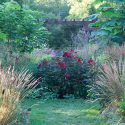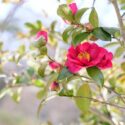Brighten Your Living Spaces with Tropical Flowers Ideal as House Plants or Garden Additions

Tropical flowers, with their vibrant colors and exotic appearances, captivate the imagination and transport us to paradisiacal landscapes. These botanical wonders thrive in the warm climates of the tropics, where the conditions of high humidity, ample rainfall, and year-round warmth foster their lush growth and spectacular blooms. From the dense rainforests of the Amazon to the sun-drenched islands of the Caribbean, tropical flowers represent the diversity and ecological richness of these regions.
Tropical flowers are not only admired for their beauty but also for their unique adaptations to their environments. Many have evolved intricate shapes and colors to attract specific pollinators, including birds, bats, and insects. Others have become symbols of cultural significance, representing love, hospitality, and friendship in various societies around the globe.
Among the most popular tropical flowers are Hibiscus, known for its large, colorful blooms; Orchids, offering unparalleled elegance and diversity; Heliconia, with its striking, vibrant inflorescences; Plumeria, beloved for its fragrant and picturesque flowers; and Strelitzia, famous as the Bird of Paradise for its unique shape and vivid colors. These genera encapsulate the exotic beauty and variety of the tropics, each contributing unique shapes, colors, and textures to landscapes and indoor settings alike.
In their native tropical environments, where seasons are less pronounced, many tropical flowers can bloom year-round. This continuous display of beauty is a stark contrast to temperate regions, where flowers have specific blooming seasons.
Many tropical flowers emit exotic and intoxicating fragrances that are not only pleasing to humans but also essential for attracting pollinators. Flowers like Plumeria and Gardenia are celebrated for their sweet and powerful scents, often used in perfumes and aromatherapy.
Tropical flowers are magnets for wildlife, especially butterflies and hummingbirds, drawn to their vivid colors and rich nectar. Butterflies frequent flowers like Pentas for their accessible nectar and vibrant hues. Hummingbirds, attracted to the colorful flowers of Heliconia, play a crucial role in pollination. The symbiotic relationship between these flowers and wildlife supports biodiversity and adds a dynamic layer of interaction and beauty to gardens.
In gardens and homes, tropical flowers bring a touch of the exotic and can be grown in greenhouses, conservatories, or as houseplants in less favorable climates. Their allure lies not just in their visual appeal but also in their ability to evoke a sense of wonder and a connection to distant, sun-soaked lands.
Whether used in landscaping, floral arrangements, or as standalone specimens, tropical flowers add a vibrant splash of color and an exotic flair. Their diversity in form, color, and scent is a testament to the incredible creativity of nature and the joy they bring to people worldwide.
Strelitzia reginae, commonly known as the Bird of Paradise, is a striking plant renowned for its large, vibrant flowers that resemble a bird in flight. Ideal for both indoor and outdoor environments, it thrives in bright, indirect sunlight indoors and enjoys warm, sunny conditions outdoors. This plant adds an exotic, tropical flair to any setting with its bold foliage and stunning blooms.
| Hardiness | 10 - 12 |
|---|---|
| Exposure | Full Sun, Partial Sun |
| Season of Interest |
Spring (Early, Mid, Late) Fall Winter |
| Height |
5' - 6' (150cm - 180cm) |
| Spread |
3' - 4' (90cm - 120cm) |
Heliconia psittacorum, or Parrot Heliconia, is an evergreen perennial with dense, bright green leaves and distinctive colorful inflorescences in hues of red, orange, yellow, and green. Blooming year-round, its nectar-rich flowers attract hummingbirds, and its waxy bracts make striking arrangements. Thriving in tropical gardens, it produces long-lasting blooms and dark blue fruits.
| Hardiness | 10 - 11 |
|---|---|
| Exposure | Full Sun, Partial Sun |
| Season of Interest |
Spring (Early, Mid, Late) Summer (Early, Mid, Late) Fall Winter |
| Height |
3' - 6' (90cm - 180cm) |
| Spread |
2' - 3' (60cm - 90cm) |
Heliconia rostrata, known as Hanging Lobster Claw, is an ornamental, evergreen perennial with large, banana-like leaves and striking flower clusters that hang from its stems in spring and summer. Bright red bracts tipped with yellow and green encase yellowish-white flowers, attracting hummingbirds and producing dark blue fruits. Ideal for tropical gardens, these long-lasting blossoms are perfect for arrangements.
| Hardiness | 10 - 11 |
|---|---|
| Exposure | Full Sun, Partial Sun |
| Season of Interest |
Spring (Early, Mid, Late) Summer (Early, Mid, Late) Fall Winter |
| Height |
4' - 6' (120cm - 180cm) |
| Spread |
3' - 6' (90cm - 180cm) |
Plumeria rubra, or Frangipani, is a deciduous shrub or small tree beloved for its succulent branches and spiral-shaped, fragrant flowers with yellow centers, blooming in terminal clusters in tropical areas. Its dark green, leathery leaves may drop in cooler winters, showcasing stubby branches. Ideal for patios or borders, its scented blooms are perfect for leis.
| Hardiness | 10 - 12 |
|---|---|
| Exposure | Full Sun |
| Season of Interest |
Spring (Early, Mid, Late) Summer (Early, Mid, Late) Fall |
| Height |
15' - 25' (4.6m - 7.6m) |
| Spread |
15' - 25' (4.6m - 7.6m) |
Anthurium andraeanum (Flamingo Flower), known for its glossy, heart-shaped spathes in vibrant red, pink, orange, or white and contrasting spadix, is a popular ornamental plant. It thrives in bright, indirect light with high humidity and blooms almost continuously in ideal conditions. It tolerates lower light conditions, but too little light may result in fewer blooms and slower growth.
| Hardiness | 11 - 12 |
|---|---|
| Exposure | Partial Sun |
| Season of Interest |
Spring (Early, Mid, Late) Summer (Early, Mid, Late) Fall Winter |
| Height |
1' - 2' (30cm - 60cm) |
| Spread |
10" - 1' (25cm - 30cm) |
Native to Brazil, Aechmea fasciata, or Urn Plant, features a striking rosette of silver and green leaves forming a vase shape. At maturity, it showcases a pink spike with purple flowers and pink bracts, lasting months. Blooming once, it produces offsets for replanting. Thrives indoors with minimal care.
| Hardiness | 10 - 11 |
|---|---|
| Exposure | Partial Sun |
| Season of Interest |
Spring (Early, Mid, Late) Summer (Early, Mid, Late) Fall Winter |
| Height |
1' - 3' (30cm - 90cm) |
| Spread |
1' - 2' (30cm - 60cm) |
Medinilla magnifica, known as the Rose Grape or Magnificent Medinilla, dazzles with its cascading pink flower clusters and glossy green leaves. Native to the Philippines, this tropical evergreen shrub thrives in humid, indirect light environments, making it a stunning indoor plant. It requires moist, well-drained soil and careful watering to bloom.
| Hardiness | 10 - 11 |
|---|---|
| Exposure | Partial Sun |
| Season of Interest |
Spring (Early, Mid, Late) Summer (Early, Mid, Late) Fall Winter |
| Height |
2' - 4' (60cm - 120cm) |
| Spread |
1' - 3' (30cm - 90cm) |
Native to Brazil, Ananas comosus, or Pineapple, is a terrestrial bromeliad with a dense rosette of spiny, gray-green leaves. It blooms in summer, producing a cone-like cluster of purple and red flowers that fuse into an edible fruit, crowned with leafy rosettes. Widely cultivated for its fruit and ornamental value, it’s a staple in tropical and subtropical regions, ranking third in tropical fruit production worldwide.
| Hardiness | 11 - 12 |
|---|---|
| Exposure | Full Sun |
| Season of Interest |
Spring (Early, Mid, Late) Summer (Early, Mid, Late) Fall Winter |
| Height |
3' - 4' (90cm - 120cm) |
| Spread |
3' - 4' (90cm - 120cm) |
Jasminum officinale (Common Jasmine) is a beloved climbing shrub with a vigorous and graceful habit. It is cherished for its sweet fragrance and bountiful clusters of fragrant flowers. Blooming from late spring to frost, it adorns its twining stems with lush green leaves and brings a delightful scent to the garden.
| Hardiness | 7 - 10 |
|---|---|
| Exposure | Full Sun, Partial Sun |
| Season of Interest |
Spring (Late) Summer (Early, Mid, Late) Fall |
| Height |
15' - 30' (4.6m - 9.1m) |
| Spread |
7' - 15' (210cm - 4.6m) |
Passiflora caerulea (Blue Passion Flower) is a captivating and vigorous climber. Its exquisite white flowers, tinged with pink, feature a mesmerizing array of blue, white, and purple filaments. The plant produces edible but mildly flavored orange fruits. With its lush green foliage and large blooms, this glamorous climber is a showstopper in any garden.
| Hardiness | 6 - 9 |
|---|---|
| Exposure | Full Sun, Partial Sun |
| Season of Interest |
Summer (Early, Mid, Late) Fall |
| Height |
20' - 30' (6.1m - 9.1m) |
| Spread |
3' - 6' (90cm - 180cm) |
Protea cynaroides, the King Protea, South Africa’s national bloom, is known for its large, bowl-shaped flower heads and colorful bracts in hues from greenish-white to pink and red. Thriving in warm climates, it blooms primarily in warmer months, with a single plant producing 6-10, sometimes up to 40, flower heads a season. Perfect for sunny gardens or containers, it’s a favored cut flower worldwide.
| Hardiness | 9 - 12 |
|---|---|
| Exposure | Full Sun |
| Season of Interest |
Spring (Early, Mid, Late) Summer (Early, Mid, Late) Fall Winter |
| Height |
3' - 4' (90cm - 120cm) |
| Spread |
3' - 4' (90cm - 120cm) |
Etlingera elatior, known as Torch Ginger, showcases tall, lush green foliage and vibrant red or pink flower spikes resembling flaming torches. Thriving in tropical climates, it’s celebrated for its striking appearance and edible buds, adding an exotic touch to gardens and culinary dishes with its architectural beauty and unique flavors.
| Hardiness | 10 - 12 |
|---|---|
| Exposure | Full Sun, Partial Sun |
| Season of Interest |
Spring (Early, Mid, Late) Summer (Early, Mid, Late) Fall Winter |
| Height |
6' - 15' (180cm - 4.6m) |
| Spread |
4' - 10' (120cm - 3m) |
Ipomoea alba, or Moonflower, captivates with its nocturnal blooms, opening at dusk to release a sweet fragrance. These large, white flowers close at dawn, set against a backdrop of heart-shaped leaves. A fast-growing vine, it’s ideal for covering fences or adorning structures, thriving as a perennial in warm climates or an annual in cooler areas.
| Hardiness | 9 - 12 |
|---|---|
| Exposure | Full Sun |
| Season of Interest |
Summer (Mid, Late) Fall |
| Height |
10' - 15' (3m - 4.6m) |
| Spread |
3' - 6' (90cm - 180cm) |
Clivia miniata, known as Natal Lily, is celebrated for its stunning blooms, featuring large clusters of orange-red, funnel-shaped flowers with yellow throats from winter to spring. These long-lasting blossoms rise above dark green, strap-shaped leaves, creating a vibrant display, followed by ornamental red berries. Its lush foliage offers year-round beauty.
| Hardiness | 9 - 11 |
|---|---|
| Exposure | Partial Sun |
| Season of Interest |
Spring (Early, Mid, Late) Summer (Early, Mid, Late) Fall Winter |
| Height |
1' - 2' (30cm - 60cm) |
| Spread |
2' - 3' (60cm - 90cm) |
Acalypha hispida, or Chenille Plant, dazzles with unique, long tassel-like bright red to pink flowers, blooming year-round. Its large, medium green leaves complement the free-flowering racemes. Ideal for tropical settings as an accent or hedge, this vigorous shrub also suits containers, making it versatile indoors and out.
| Hardiness | 10 - 11 |
|---|---|
| Exposure | Full Sun, Partial Sun |
| Season of Interest |
Spring (Early, Mid, Late) Summer (Early, Mid, Late) Fall Winter |
| Height |
4' - 6' (120cm - 180cm) |
| Spread |
6' - 8' (180cm - 240cm) |
Alpinia zerumbet, known as Shell Ginger, is a tropical perennial with dark green, lance-shaped leaves that emit a ginger scent when crushed. In summer, it blooms with waxy, fragrant flowers in clusters, adding beauty to tropical gardens, containers, or as a houseplant. Valued for spice, food, medicine, and ornamental use, it thrives in most tropical regions, offering a dense foliage display perfect for mass planting.
| Hardiness | 8 - 11 |
|---|---|
| Exposure | Full Sun, Partial Sun |
| Season of Interest |
Spring (Early, Mid, Late) Summer (Early, Mid, Late) Fall Winter |
| Height |
3' - 10' (90cm - 3m) |
| Spread |
2' - 4' (60cm - 120cm) |
Hedychium coronarium, or White Ginger Lily, an award-winner for its rich fragrance, is a perennial with dense spikes of fragrant, white flowers resembling butterflies, blooming in late summer to early fall. Each blossom lasts a day, contributing to a 6-week display above lance-shaped leaves. Ideal for tropical-themed patios and containers.
| Hardiness | 7 - 11 |
|---|---|
| Exposure | Full Sun, Partial Sun |
| Season of Interest |
Summer (Late) Fall |
| Height |
3' - 6' (90cm - 180cm) |
| Spread |
2' - 3' (60cm - 90cm) |
Hedychium gardnerianum, or Kahili Ginger, is an award-winning perennial with striking lemon-yellow flowers and long red stamens on cylindrical spikes, blooming late summer to early fall. Its gray-green, lance-shaped leaves add drama even without blooms, perfect for tropical-themed patios. Hardy and architectural, it adds an exotic touch to gardens and containers.
| Hardiness | 8 - 10 |
|---|---|
| Exposure | Full Sun, Partial Sun |
| Season of Interest |
Summer (Late) Fall |
| Height |
5' - 6' (150cm - 180cm) |
| Spread |
2' - 3' (60cm - 90cm) |
Hedychium flavescens, or Yellow Ginger Lily, features clusters of spicily-scented, pale to lemon yellow flowers in late summer and fall. Its fragrant blossoms, atop stems with pointed, softly hairy leaves, enhance any tropical-themed patio or deck. This upright perennial adds luminous beauty even when not in bloom.
| Hardiness | 9 - 11 |
|---|---|
| Exposure | Full Sun, Partial Sun |
| Season of Interest |
Summer (Late) Fall |
| Height |
3' - 6' (90cm - 180cm) |
| Spread |
2' - 3' (60cm - 90cm) |
Plumbago auriculata (Cape Leadwort) is a versatile evergreen, functioning as a vine or mounding shrub. It produces a bounty of sky-blue, trumpet-shaped flowers on racemes, blooming from spring through summer or year-round in frost-free areas. Its slender stems with light green leaves form a shrub-like mass, perfect for trellises, groundcovers, containers, or cascading walls, showcasing its unique blue blooms.
| Hardiness | 8 - 11 |
|---|---|
| Exposure | Full Sun, Partial Sun |
| Season of Interest |
Spring (Early, Mid, Late) Summer (Early, Mid, Late) Fall Winter |
| Height |
6' - 10' (180cm - 3m) |
| Spread |
8' - 10' (240cm - 3m) |
Cordyline fruticosa, or Ti Plant, is cherished as a houseplant for its vividly colored leaves ranging from pink to burgundy, green, and cream. Spirally arranged into a fan shape, these leaves, alongside summer blooms and red berries, add tropical flair. Beloved in Hawaiian culture for luck and culinary use, it thrives in warm, humid settings.
| Hardiness | 10 - 12 |
|---|---|
| Exposure | Full Sun, Partial Sun |
| Season of Interest |
Spring (Early, Mid, Late) Summer (Early, Mid, Late) Fall Winter |
| Height |
9' - 15' (270cm - 4.6m) |
| Spread |
3' - 8' (90cm - 240cm) |
Gardenia jasminoides (Cape Jasmine) is a large evergreen shrub with thick, lustrous, lance-shaped, dark green leaves and extremely fragrant, white flowers, 3 in. across (8 cm). Blooming throughout the year in warm climates, where temperatures do not drop below 60°F (15°C), this award-winning Gardenia blooms in late spring to early summer in cooler climates.
| Hardiness | 8 - 11 |
|---|---|
| Exposure | Full Sun, Partial Sun |
| Season of Interest |
Spring (Early, Mid, Late) Summer (Early, Mid, Late) Fall Winter |
| Height |
3' - 6' (90cm - 180cm) |
| Spread |
3' - 6' (90cm - 180cm) |
Poinsettias, beloved Christmas adornments, are deciduous to semi-evergreen shrubs. They dazzle with red, pink, or cream leafy bracts, blooming from winter to spring. Delicate yellow flowers grace the bract centers, enhancing their charm. Opt for bracts with minimal yellow pollen to ensure longevity. These Mexico natives require a steady 55ºF (18ºC) temperature for vibrant hues due to their frost sensitivity. Poinsettias, with ovate, toothed leaves, thrive as potted plants. Dominating holiday décor, they reign as top-selling potted plants with 100+ varieties.
| Hardiness | 9 - 11 |
|---|---|
| Exposure | Full Sun, Partial Sun |
| Season of Interest |
Spring (Early) Winter |
| Height |
3' - 10' (90cm - 3m) |
| Spread |
3' - 7' (90cm - 210cm) |
One of the most flamboyant flowering shrubs, Tropical Hibiscus add color and excitement to landscapes, patios and decks. Cultivated for centuries, Tropical Hibiscus flourish in sub-tropical climates and adapt well to container-growing in cooler areas.
| Hardiness | 10 - 12 |
|---|---|
| Exposure | Full Sun, Partial Sun |
| Season of Interest |
Spring (Early, Mid, Late) Summer (Early, Mid, Late) Fall Winter |
Orchid is one of the largest families of flowering plants, with over 25,000 species and more than 100,000 hybrids. They are found on every continent except Antarctica, and their wide distribution and adaptability make them a fascinating group of plants to study and cultivate.
Bougainvillea is a vibrant, evergreen climbing shrub adorned with colorful bracts surrounding small, tubular flowers. Its fast-growing, low-maintenance nature makes it an eye-catching addition to gardens and landscapes.
| Hardiness | 9 - 11 |
|---|---|
| Exposure | Full Sun |
| Season of Interest |
Spring (Early, Mid, Late) Summer (Early, Mid, Late) Fall Winter |
| Height |
2' - 40' (60cm - 12.2m) |
| Spread |
6' - 20' (180cm - 6.1m) |
Native to South Africa, the Calla Lily, also known as Zantedeschia or Arum Lily, is a striking genus of flowering plants. Renowned for their unique, chalice-shaped flowers (spathes) that encircle a yellow, finger-like stalk (spadix), Calla Lilies are a popular choice for both gardens and household settings. With their arrow-shaped, often spotted leaves, Calla Lilies make a magnificent impact in any setting, whether as part of garden borders, container arrangements, or as cut flowers.
| Hardiness | 7 - 10 |
|---|---|
| Exposure | Full Sun, Partial Sun |
| Season of Interest |
Spring (Late) Summer (Early, Mid, Late) Fall |
| Height |
1' - 3' (30cm - 90cm) |
| Spread |
1' - 2' (30cm - 60cm) |
Brugmansia, also known as Angel’s Trumpets, are highly valued for their tropical appearance and striking trumpet-shaped blossoms. These evergreen shrubs or small trees offer both beauty and fragrance, with their powerful scent released primarily in the evenings. Long-lived and decorative, they bring dramatic flair to gardens and containers with relative ease.
| Hardiness | 9 - 11 |
|---|---|
| Exposure | Full Sun, Partial Sun |
| Season of Interest |
Summer (Mid, Late) Fall |
Canna, also known as Canna lily or Indian shot, is a tropical perennial plant appreciated for its vibrant flowers and striking foliage. With large paddle-shaped leaves and showy blooms in a range of colors including red, orange, yellow, and pink, they add a bold and tropical element to gardens. They thrive in warm climates and can be grown in containers or as bedding plants.
| Hardiness | 8 - 11 |
|---|---|
| Exposure | Full Sun |
| Season of Interest |
Summer (Early, Mid, Late) Fall |
| Height |
2' - 8' (60cm - 240cm) |
| Spread |
1' - 3' (30cm - 90cm) |
Pentas burst into a kaleidoscope of starry blooms, creating a buzz in gardens with their vivid colors. These sun-loving beauties are a magnet for fluttering butterflies and darting hummingbirds, offering a lively display from spring through autumn and adding an effervescent charm to any outdoor space.
| Hardiness | 10 - 11 |
|---|---|
| Exposure | Full Sun, Partial Sun |
| Season of Interest |
Spring (Early, Mid, Late) Summer (Early, Mid, Late) Fall Winter |
| Height |
1' - 3' (30cm - 90cm) |
| Spread |
1' - 3' (30cm - 90cm) |
Growing and caring for tropical flowers involves creating an environment that mimics their natural, warm, and humid habitat. Here are key guidelines:
Most tropical flowers require bright, indirect light. Direct sunlight can scorch their leaves, while too little light may hinder bloom production. Position them near a window where they’ll receive ample light but be shielded from intense midday sun.
Tropical plants generally prefer temperatures between 65°F and 85°F (18°C to 29°C). Avoid exposing them to temperatures below 50°F (10°C) to prevent stress.
High humidity levels, typically between 50% and 70%, are crucial. Increase humidity with a humidifier, pebble trays filled with water, or regular misting.
Water tropical flowers when the top inch of soil feels dry to the touch. They like moisture but cannot tolerate waterlogged conditions. Ensure pots have drainage holes to prevent root rot.
Use a well-draining, rich potting mix. Many tropical flowers benefit from soil with good aeration and organic matter. Amend standard potting soil with perlite or vermiculite and compost to improve drainage and nutrient content.
Feed tropical flowers during their growing season (spring and summer) with a balanced, water-soluble fertilizer every 2-4 weeks. Reduce feeding in the fall and winter when growth slows.
Prune to remove dead or damaged foliage and to shape the plant. This encourages new growth and can help maintain a desirable size.
Inspect regularly for signs of pests like aphids, spider mites, and mealybugs. Treat infestations early with insecticidal soap or neem oil. Prevent fungal diseases by avoiding overhead watering and allowing for good air circulation.
When bringing new plants home or moving them outdoors in summer, acclimate them gradually to prevent shock from sudden changes in light or temperature.
The Hibiscus is often considered the most popular tropical flower due to its wide recognition, vibrant colors, and large, showy blooms. It symbolizes tropical beauty globally and is found in many tropical and subtropical regions.
The Plumeria, with its sweet fragrance and beautiful blooms, is iconic to Hawaii. Another quintessentially Hawaiian flower is the Hibiscus, particularly the yellow Hibiscus, which is Hawaii’s state flower.
The Bougainvillea is a stunning flower often associated with the Caribbean. Its vibrant, paper-like blooms in shades of pink, red, orange, purple, and white adorn landscapes throughout the region, reflecting the area’s vibrant culture and environment.
The Yellow Hibiscus (Hibiscus brackenridgei), designated as the state flower of Hawaii, holds this title. It’s celebrated for its large, sunny-yellow flowers and is a symbol of Hawaiian aloha and spirit.
Beauty is subjective, but the Bird of Paradise (Strelitzia reginae) is often hailed as one of the most beautiful tropical flowers. Its striking appearance, resembling a bird in flight, along with vibrant colors, makes it a breathtaking sight.
The Heliconia, also known as lobster claws, is sometimes referred to as the king of tropical flowers. Its bold, striking inflorescences and vibrant colors dominate the tropical landscape, making a commanding presence.
The Orchid is often considered the queen of tropical flowers, due to its unparalleled elegance, exotic beauty, and vast diversity. Orchids are highly revered and represent sophistication and luxury in the floral world.
Small trees and shrubs that bloom in winter offer a rare and enchanting spectacle, defying the dormant season with their vibrant blossoms. These resilient species illuminate the garden with their colorful flowers, providing unexpected joy and a feast for the senses during the coldest months, while offering crucial sustenance to local wildlife.
Small trees and shrubs, particularly those that bear fruits or berries, play a pivotal role in attracting a variety of birds, including American Robins, Bluebirds, Mockingbirds, Blue Jays, Goldfinches, House Finches, and Northern Cardinals. These plants offer birds nourishment through their fruits and seeds, and provide shelter and nesting sites, enhancing biodiversity in gardens and wild areas.
As the warmth of summer fades and leaves begin to turn, certain small trees and shrubs grace the autumn landscape with their blossoms. These botanical marvels, including witch hazel, beautyberry, camellia and rose of sharon, bring bursts of color and vibrancy, enriching the fall scenery and delighting garden enthusiasts with their late-season blooms.
Enhance your garden’s privacy and allure year-round with evergreen trees. Arborvitae, Leyland Cypress, Holly, and Fir stand out for their dense foliage, offering a living barrier that thrives through all seasons. These steadfast greens provide not just seclusion but also enduring beauty, making any outdoor space a tranquil retreat.
Opt for small trees to transform tiny gardens into lush havens. Choose from varieties like Japanese Maple for fiery fall colors, Crabapple for spring blossoms, or Witch Hazel for winter blooms. These compact trees offer year-round beauty, from vibrant foliage to unique forms, making every small space a botanical delight.
Flowering trees, with their breathtaking blooms, are essential for any garden seeking vibrancy and allure. Choices range from the majestic Magnolia to the graceful Dogwood, vibrant Crepe Myrtle, or stunning Jacaranda, each offering unique colors, scents, and textures. These natural beauties provide not just aesthetic appeal but also support local ecosystems and wildlife.
Blue flowers, symbolizing serenity and tranquility, add a unique and soothing touch to any garden. From the vibrant azure of delphiniums to the subtle hues of bluebells, these blooms create a cooling effect, contrasting beautifully with warmer colors. They attract pollinators and add a rare and enchanting element to landscapes.
Pink flowers can bring a pop of color and a sense of joy to any garden or floral arrangement. From delicate pastel hues to bright and bold shades, there are a variety of pink flowers to choose from, such as roses, peonies, and carnations.
Purple flowers are some of the most captivating and attractive flowers in the world. They add beauty and a touch of elegance to any garden or floral arrangement. They are available in a wide range of shades and hues, ranging from light lilacs to deep purples. These flowers can also come in various sizes, shapes, and textures.
Incorporating white flowers in gardens introduces a touch of timeless elegance and tranquility. From the serene glow of lilies and peonies to the delicate charm of baby’s breath and jasmine, these blooms create a soothing ambiance, beautifully contrasting with green foliage and enhancing the garden’s peacefulness under moonlit skies.
For stunning fall color, consider planting Sugar Maples for vibrant oranges and reds, Birch trees for bright yellows, and Red Oaks for deep red hues. Dogwoods offer a mix of purples and reds, while Ginkgoes light up landscapes with bold yellows, creating a breathtaking autumn display in any garden.
Planting an oak tree offers numerous benefits: it provides a vital habitat and food source for wildlife, significantly sequesters carbon to combat climate change, improves air quality by filtering pollutants, enriches soil health through its leaf litter, and aids in water conservation with its extensive root system.
Dogwood trees and shrubs offer a diverse array of choices for gardeners. Popular varieties include the flowering dogwood (Cornus florida) with its iconic white or pink blooms, the kousa dogwood (Cornus kousa) known for its late-spring flowering, and the red-twig dogwood (Cornus sericea) prized for its vibrant red branches in winter.
Ideal for container gardening, select shrubs like compact evergreens, dwarf flowering varieties, and hardy herbs offer year-round appeal and versatility. Adaptable to limited space, these shrubs provide a lush, vibrant display on patios, balconies, and terraces, enhancing outdoor living areas with minimal maintenance and maximum beauty.
Crafting an enchanting hedge in your garden is a rewarding endeavor. Hedges serve as living boundaries, offering privacy, beauty, and structure. Explore a world of possibilities with various shrubs, each contributing its unique charm to create the hedge that suits your landscape vision.
Small evergreen shrubs are the unsung heroes of landscaping, providing year-round beauty without the hassle. Boxwood, lavender, and other varieties offer enduring charm, require minimal maintenance, and thrive effortlessly in your garden, making them the perfect choice for a vibrant, low-maintenance landscape.
Discover the perfect flowering shrubs for small gardens. These compact beauties offer vibrant blooms, lush foliage, and space-saving charm, enhancing your small garden’s allure without overwhelming it.
Enhance your garden with flowering shrubs that love the sun! These vibrant, sun-loving plants bring color, fragrance, and life, even in the brightest spots. Ideal for creating dynamic landscapes, they offer varied blooms and sizes, perfect for any garden seeking a burst of color and natural beauty.












Create a membership account to save your garden designs and to view them on any device.
Becoming a contributing member of Gardenia is easy and can be done in just a few minutes. If you provide us with your name, email address and the payment of a modest $25 annual membership fee, you will become a full member, enabling you to design and save up to 25 of your garden design ideas.
Join now and start creating your dream garden!
Create a membership account to save your garden designs and to view them on any device.
Becoming a contributing member of Gardenia is easy and can be done in just a few minutes. If you provide us with your name, email address and the payment of a modest $25 annual membership fee, you will become a full member, enabling you to design and save up to 25 of your garden design ideas.
Join now and start creating your dream garden!